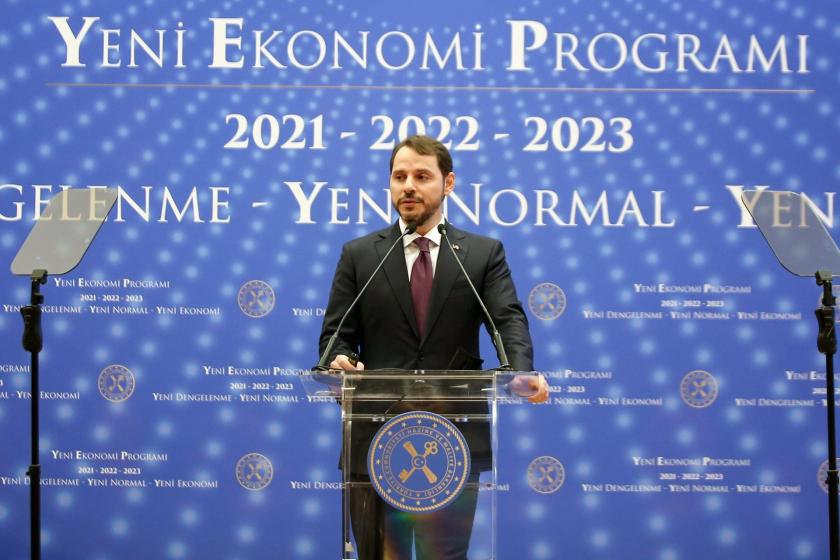01 October 2020 18:17
Such headings as “Making the labour market flexible” or “Distance and flexible working models in the new normal” harbinger the wish for the foundations to be laid of the flexible and insecure working spoken of for years.
 Erkan Aydoğanoğlu
Erkan Aydoğanoğlu

Berat Albayrak | Photograph: AA
The “New Economic Programme” (NEP) covering the years 2021-2023 has been announced by Minister of Treasury and Finance Berat Albayrak. Just as with all the economic programmes announced until now, there appears to have been no change in the government’s political and class priorities as regards its aims and goals in the new NEP.
The excessively optimistic assessments contained in the New Economic Programme and the goals set come across as an “economic wish list” most of which are out of synch with economic realities and will come as convincing to no right-minded person, rather than an “economic programme” in the recognized sense.
There is a lack of adequate substance behind the bold claims featuring under the heading, “Three new challenges: new balance, new normal, new economy” contained in the Ministry of Treasury and Finance’s presentation. It is not entirely clear who or which problem is being challenged in the economic programme.
Per-capita GDP of 8,381 dollars has been envisaged for 2020 in the NEP. This forecast takes Turkey back thirteen years in terms of per-capita GDP. With investment continuing to decline in the public and private sectors, it seems that economic growth will, as until now, predominantly be driven by consumption expenditure.
There is absolutely no mention of such realistic goals as the government taking steps to mitigate as far as possible epidemic-related lost employment and income, effectuating genuine job-boosting policies, easing the tax burden shouldered by working people or adopting wage policies that meet wage-earning workers’ basic needs (exempting the minimum wage from tax, additional raises, ending the tax bracket rip-off for workers, reflection of supplementary payments in wages, etc.).
There is no palpable proposal or target in the NEP regarding such problems as unemployment, insecurity, the high cost of living, rising poverty and high indebtedness which number among Turkey’s basic economic problems awaiting solution.
Despite the Central Bank drawing on close to one hundred billion dollars in foreign exchange reserves in the first nine months of the year to keep the exchange rate at a certain level, this was to no avail in preventing sudden increases in the dollar exchange rate. Inflation has long languished in double figures and the rise in foreign exchange rates will push inflation far higher in coming months. With the devaluation in excess of thirty per cent of the Turkish lira from new year until now expected to stoke up inflation, the prediction for 2020 inflation in the NEP of 10.5 per cent (consumer price index) is totally unrealistic.
With millions of workers losing their jobs and income under Covid-19 epidemic conditions, the extreme devaluation the Turkish lira has suffered over the past three years has greatly diminished the people’s purchasing power. As the budget deficit rises, the government is left with little choice apart from fresh price increases, increased taxes and borrowing at high interest rates to close the budget deficit. With price increases of basic consumption items accelerating, inflation is bound to shoot well above the NEP target as a remedy is sought in fresh tax hikes to fill a budget deficit that has doubled.
With proud mention made in the NEP presentation of the incentives and implementations and the loans given through banks directed at capital and big bosses, apart from hopes and wishes, not a single concrete target or step has been tabled with respect to the unemployment and job problems that millions of workers face. For example, according to the NEP, employment is expected to decline by 1.347 million people by the end of 2020 as against 2019. This renders meaningless talk of, “Annual average employment increasing by 1.336 million people and unemployment levels decreasing in a staged manner despite increased workforce participation rates over the course of the programme.”
The forecast narrowly-defined unemployment rate of 13.8 per cent for 2020 based on the narrowly-defined unemployment rate announced by the Turkish Statistical Institute fails in any way to reflect the narrowly-defined unemployment rate. With the negative impact of the epidemic on job availability and unemployment expected to continue, the true unemployment figures will inevitably be at least two and half times those announced by the Turkish Statistical Institute.
Apart from the inflation and unemployment goals, the assessments and targets made with regard to budget balances and the current account deficit also appear to be contradictory and inconsistent. For example, growth of 0.3 per cent is forecast, while the Turkish economy is seen with certainty shrinking in 2020. With, on the one hand, economic growth of 5.8 per cent targeted in 2021, to claim, on the other, that the current account deficit will only be 1.5 per cent of GDP is to ignore the converse relationship between growth and the current account deficit.
With talk of turning difficulties into opportunities in the New Economic Programme period, the targets relating to working life show once more that sights will be set as ever on the acquired rights of working people. An increase in flexible and insecure working arrangements so that, “working processes and models which support value-added production will become widespread” is targeted. To this end, the implementation of more flexible conditions is envisaged to enhance the employability of young people aged under 25 and workers over 50.
Such headings as “Making the labour market flexible,” “Incentivizing part-time working” or “Distance and flexible working models in the new normal” harbinger the wish for the foundations to be laid of the flexible and insecure working spoken of for years. Additionally, it is claimed that, by incentivizing full-time workers aged over 50 to transition to part-time working, “The work-life balance will be made healthier” by this means. The aim, by targeting an increase part-time working for young people and workers of an advanced age, is for the effective elimination of the right to severance pay and thereby for a squeeze to be placed on amounts of severance pay due.
At a time in which no solution is forthcoming for the high unemployment problem, flexible and insecure employment is spreading throughout the public and private sector and the government has its sights forever set on workers’ severance pay, the new NEP offers workers nothing apart from further losses of rights to the accompaniment of flexible and insecure working.
In August 2021, the sixth period collective labour agreement covering the years 2022-2023 will be made between the government and public workers’ unions. To nip in the bud demands public workers will table in view of their economic losses, there has been blatant talk like last year of adjusting certain prices and fees the public sector holds sway over in accordance with the NEP inflation targets rather than last year’s inflation and thus restricting inflation inertia (wage increases increasing inflation).
The aim is for job descriptions for public staff and positions to be made, staff requirement levels to be ascertained and for staff in excess of requirement to be reassigned taking account of job descriptions and competences. We encounter a further goal in the public sector, just as in the private sector, for the establishing of a “Public Human Resources Management System” that will lead to the creation of a goal and competence-based performance evaluation system and the rewarding of successful staff
The economic crisis is already giving every indication that it will assume far harsher proportions for the millions whose purchasing power is in constant decline due to the high cost of living and who are mired in debt, and a tough time beckons for workers and wage earners going ahead.
Under conditions in which, under the threat of unemployment and epidemic, millions of people, a fair number of them forced to work at below the minimum wage, can take no more, it appears impossible for an economic programme that goes nowhere near solving the country’s and workers’ basic problems to succeed.



